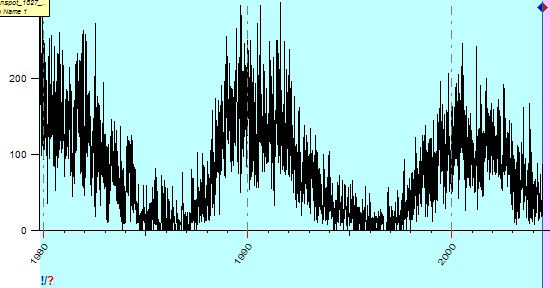
Forecast for coffee prices in three mouse clicks
written by Sergey Tarassov
Introduction
Counting Mouse clicks
Buy/Sell Signals
This article regards to the forecasting model based on astronomical cycles.
Before any discussion, I would like to mention some fact that I have faced doing the research for commodities. My goal was to create a forecasting model for coffee prices. I have started with the first thing that I usually do - calculating the spectrum. My assumption was that commodities are related to the seasonal activity; therefore, the annual cycle (=1 year) or some of its variations should be presented. To my great surprise, I could not find this cycle there. Instead of 1 year cycle, I have found 312-320 days cycle (depending on the algorithm for calculating the spectrum). It is not the annual cycle, but a kind of its remains. I have got this result for coffee. To check this thing, I have calculated the spectrum for other commodities - and have been surprised to find this 320-days cycle almost everywhere (for 8 types of commodities from 9). It varies from 310 to 330 days. Right now I see only one explanation of this fact: we deal with a regular annual cycle, but it interacts non-obviously with some other, more longer cycle - with a period of 7-11 years. The longer cycle might be the sun spot activity cycle. For example, the sun spot activity from 1980 year looks like this:

In other words, we can suppose that the seasonal price for any commodity varies depending on the current phase of the sunspot activity cycle (or some other cycle with the period of 7-11 years). The only one thing comes to my mind regarding this issue: in 1801, William Hershel has discovered the relationship between the sunspot activity and the price of wheat.
I have no intention to go now into the history of the research in economy nor into the discussion of different theories. The main goal of this article is rather more pragmatic: how to create the reliable projection line for coffee prices. And the first question arises: what cycles are the main players for this commodity - seasonal cycles, any other cycles that can be revealed by the Spectrum module or astronomical cycles?
I did not find pure seasonal cycles for coffee. Those who are familiar with this website probably can easily do the Spectrum analysis themselves. I will show now how the astronomical cycles work for this particular commodity. The usage of any other forecasting techniques (like a model based on fixed cycles extracted from Spectrum) does not provide the reliable forecast.
Timing Solution software has one feature that I like pretty much: the presence of two buttons. Click on any of these two buttons; the program itself will conduct many operations saving your time and efforts. These buttons allow to get the forecast right away. Here they are:

As I mentioned above, I used the astronomy based model to create a forecasting model for coffee prices. So, let us count the mouse clicks.
Click #1: Click the button next to "Astronomy" button:
Click #2: You will get the window to set the parameters for astronomical model. A lot of time has been spent to find the best options to be recommended; now these best options are set "by default". The research regarding this issue will be continued, and you will be informed about other possible settings.
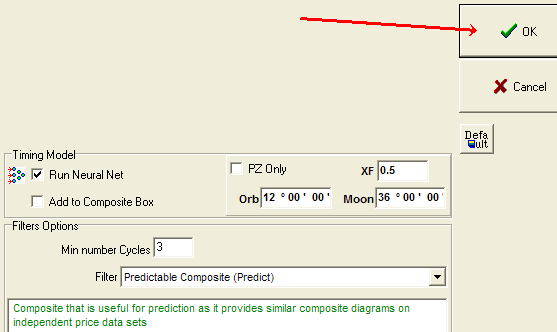
Look at proposed settings and then click "OK". The program will start working, and it is a time for you to relax and wait for a few minutes: it is a huge job to reveal the most influent astronomical cycles.
Click #3: Now you are prepared to run the Neural Net module; click on the "Training" button:
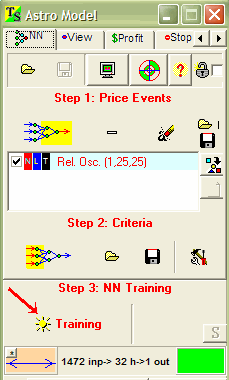
You can observe how Neural Net is creating the projection line. We use the price data from 1980 to 05.05.2001 to train the Neural Net. The data from May 5, 2001 (05.05.2001) to February 2005 are used to check the projection line generated by this model. This is the projection line (the red curve):
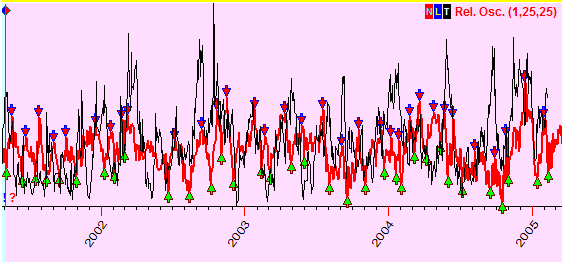
The statistical analysis definitely shows that the projection line reflects the real price movement. The coefficient of correlation changes during the training procedure between 0.15-0.225. It means that this curve explains 20% of all price movements:
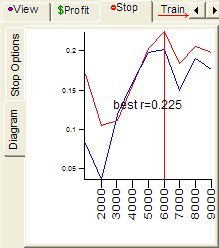
This is an impressive result, because this model provides a rather good forecast for 4 years, and it is not the annual based model. It reflects some other process.
If the good projection line has been found, you can create the buy/sell signals to specify your trading strategy.
It is very easy to do with the new feature of the program. You need just drag the mouse through any time interval in the main window and you get the strategy report for this selected time interval. I have selected a part of the testing interval, from 05.05.2001 to February 2005, to estimate the real buy/sell performance of this model. Here is the report:
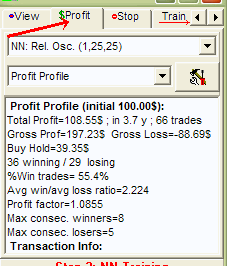
This model provides 108% profit for 3.7 years, while buy/hold strategy gives only 39% profit. 55.4% trades are winning (36 winning /26 losing). Commissions and slippage are not included.
Caution: use the buy/sell signals only for a projection line that has a good correlation to the price. The correlation is the primary measure to estimate the model's performance, while the buy/sell strategy parameters are the secondary one. This is the main difference between methods of Technical Analysis and methods provided in Timing Solution.
To optimize the buy/sell signal strategy, click on this button:
![]()
You will get this window:
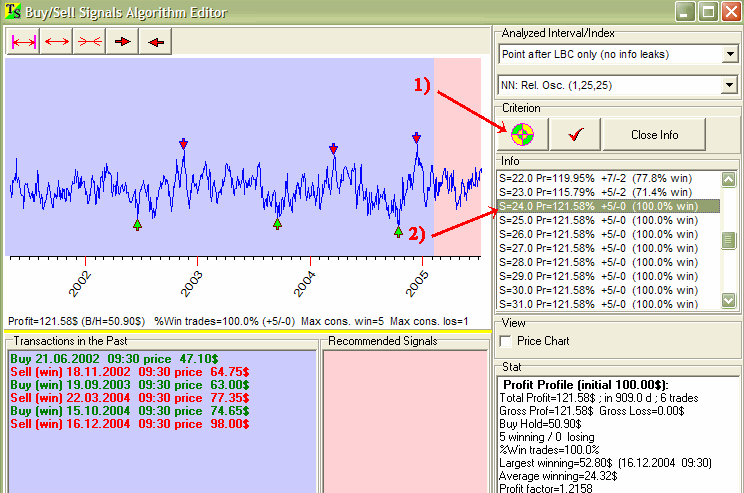
To calculate buy/sell signals, we use the "wing" parameter. This is some kind of spread value but applied to the projection curve. The smaller wing parameters are, the more buy/sell signal will be generated. To find the best strategy for you, click on "target" button (1).
You will get the list with different parameters. For example,
the
string ![]() means: if we
use 24% wing, we get a profit 121.58% (initial capital $100), 5 winning and 0 loss
trades.
means: if we
use 24% wing, we get a profit 121.58% (initial capital $100), 5 winning and 0 loss
trades.
Also I recommend to watch the parameter: ![]() -
max and min consequences winners/losers. The big losers values may indicate that this
buy/sell strategy just follows a trend tendency. Therefore, you will have
more winning trades when the trend is present and more losses when the trend is
obscure confirming the conclusion of Technical Analysis experts: "Trend is
your friend".
-
max and min consequences winners/losers. The big losers values may indicate that this
buy/sell strategy just follows a trend tendency. Therefore, you will have
more winning trades when the trend is present and more losses when the trend is
obscure confirming the conclusion of Technical Analysis experts: "Trend is
your friend".
To see the future projection for buy/sell signals, click on this button:

You will get this window:
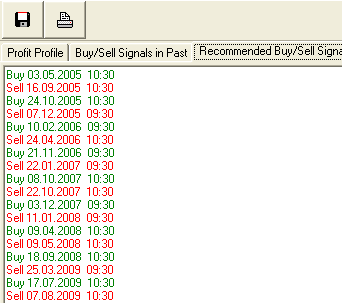
We continue to develop the buy/sell strategy system. Right now, it is only an experimental technique. You are invited to share your opinion regarding this method. After more extended testing, it will be announced in the future upgrades of the program.
March 12, 2005
Toronto, Canada.